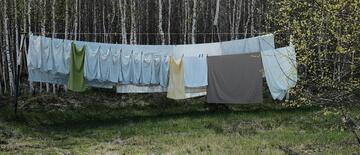WHICH FABRIC IS MORE SUSTAINABLE?

Let's find out also about new eco-friendly fabrics!
Let’s start with one of the most popular fabrics: COTTON. It comes from a plant and 90% of its fiber consists of cellulose, leading us to think it is a sustainable material. However, this natural fiber causes problems due to high water consumption, pesticide levels and pollution when over-farmed. This awareness has started a movement towards more sustainable and ethically produced cotton, such as ORGANIC COTTON that is cultivated without harmful chemicals, and FAIR-TRADE COTTON, which ensures fair trading practices and just compensation for farmers.
Also other organic fabrics are considered eco-friendly, for example:
- ORGANIC HEMP has many benefits,including the fact that it grows all around the world, it requires very little amount of water, zero pesticide, and naturally fertilises the soil it grows in.
- ORGANIC LINEN, derived from flax plants, needs minimal water and pesticides, and even grows in poor quality soil. Additionally, every part of the plant is used, so nothing is wasted. But because of the dense nature of the fiber, to get a pure white linen, it has to go through a heavy bleaching process. Unbleached linen, characterized by a beige or grey shade, is usually more eco- friendly.
The less sustainable fabrics are the SYNTHETICS ones. Synthetics have different properties to natural fibers, and are often chosen because they are very stretchy, more waterproof, and more stain-resistant than others. Examples of this kind of fabric are NYLON and POLYESTER. As they come from fossil-fuel-derived resources including petroleum-based chemicals and petrochemicals, they often release microplastics during use and washing. Moreover they need a large amount of energy and water, used for cooling in the energy-intensive process. This can be particularly dangerous in particular in areas of water scarcity, resulting in reduced access to clean drinking water. Moreover, the excess water from production is full of chemical dyes that can cause harm to plants, animals, and humans.
Environmental and social risks are also linked to the fabrics we take for sustainable. This is the case with MAN MADE CELLULOSICS (MMCFs), such as VISCOSE and LYOCELL, which are made from wood cellulose. Although renewable and potentially climate-friendly, if produced sustainably, these fibers can contribute to deforestation and threaten the biodiversity and rights of indigenous peoples linked to those territories.
There are also some innovative materials that are less known, or not known at all:
- PIÑATEX is a material made from pineapple leaf fiber. This is especially great because pineapple leaves are traditionally discarded. Moreover, it can be considered a vegan leather, but not made from plastic, which isn’t sustainable at all.
- QMONOS is a really interesting fabric, since it is synthetic spider silk developed using spider genes and microbes. Since it’s synthetic, it’s also vegan-friendly. The fiber is five times stronger than steel, yet light and flexible. Although Qmonos is a great sustainable fabric choice, being completely biodegradable, it is very expensive and rare.
Let’s come now to the ones that are probably the most quoted materials lately: RECYCLED FABRICS.
There is for example RECYCLED COTTON or RECYCLED POLYESTER. This last is really interesting since traditional polyester is usually one of the worst offenders. It’s often made from plastic bottles, therefore, it reduces the amount of plastic waste sent to landfills and skips the intensive process that normal polyester goes through. However, it is worth noting that recycled polyester still releases microplastics when washed. The same goes for ECONYL, a fibre made from synthetic waste including industrial plastic and ocean fishing nets. The result is extremely similar to nylon, making Econyl a kind of recycled nylon.
Another option for being sustainable is surely buying second hand clothes, so that there is no need for producing new ones! :)

